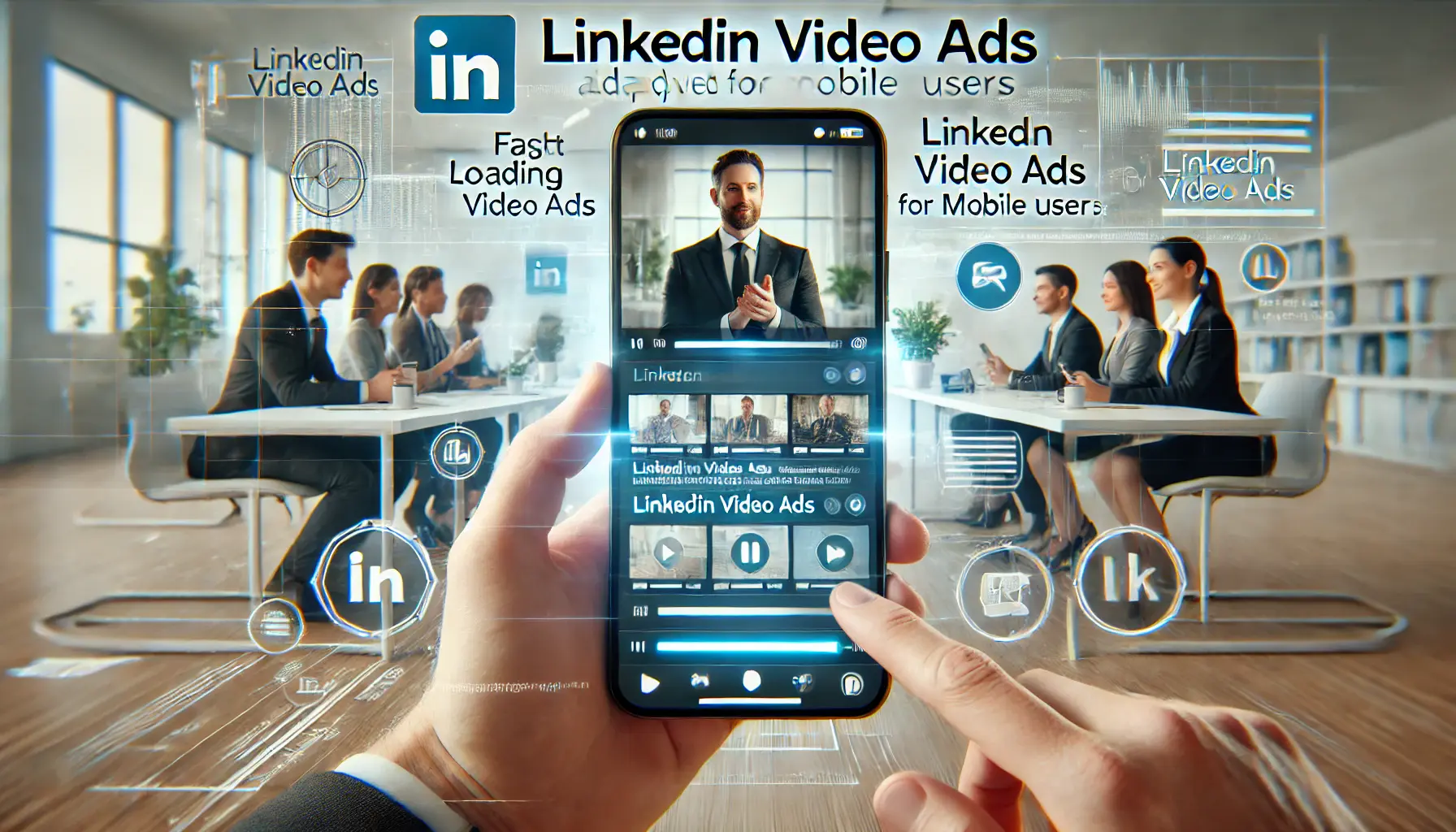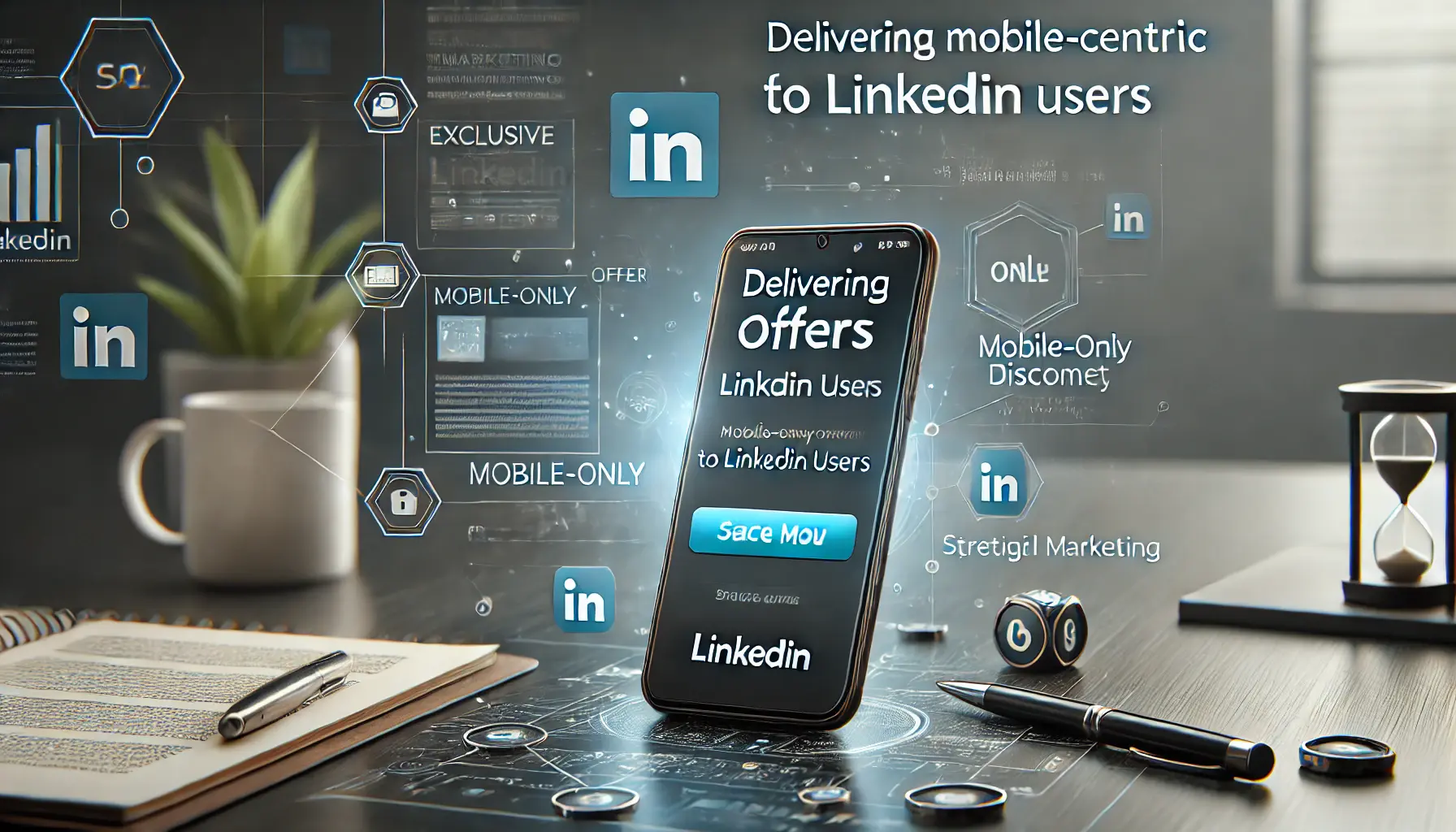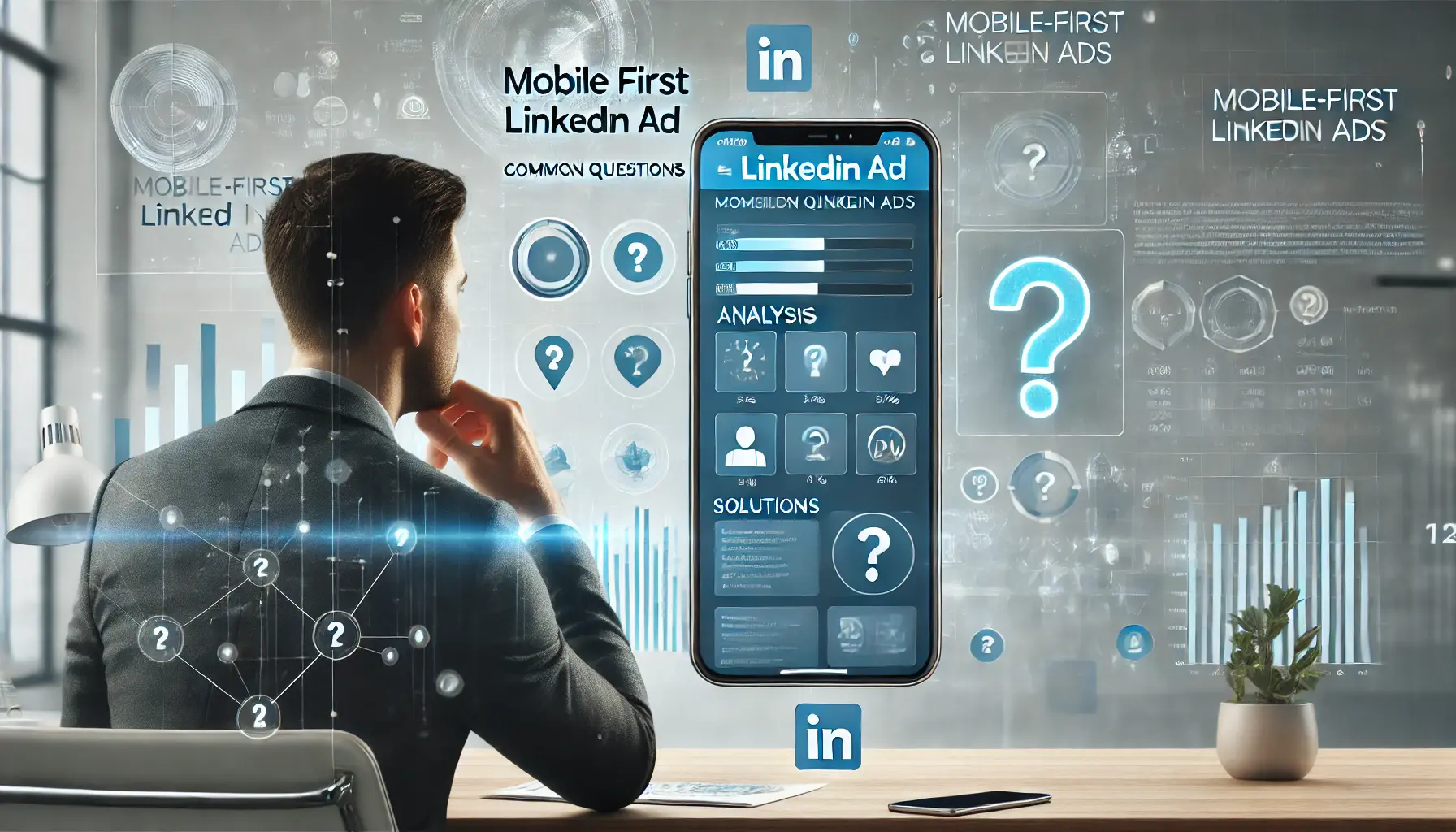With today’s warp speed of everything going digital, Mobile First is the way to go for LinkedIn, where people more so than ever are dedicated phone users.
This change also means advertisers need to refocus their strategies in order to adequately reach viewers on diminutiveExtremely small or tiny in size. screens.
Introduce the notion of Mobile First, a process that focuses on mobile users through creating ad experiences made ready for mobile.
Applied to LinkedIn Ads, this can dramatically improve the performance of your campaigns — lifting engagement and generating better outcomes.
So how do you go about implementing a Mobile First approach to LinkedIn Ads?
Here, we will look at the top 4 Mobile First strategies that can significantly boost your LinkedIn ad campaigns to keep you ahead in a mobile-centric world.
So, for those who are looking to improve your B2B strategy with advertising on LinkedIn — or you just got started and need some help — these tips should navigate you through the necessary steps.
- The Importance of Mobile First for High-Performing LinkedIn Ads
- Top Mobile Ad Formats for a Mobile First Strategy on LinkedIn
- Purposefully and Effectively Targeting LinkedIn Audiences on Mobile
- Mobile-Optimized Content for LinkedIn Ads
- How to Measure and Optimize Ad Improvements on LinkedIn with Mobile First
- Conclusion on a Mobile First Approach to LinkedIn Ads
- Mobile First LinkedIn Ads: Common Questions
The Importance of Mobile First for High-Performing LinkedIn Ads
As mobile traffic continues to claim a higher percentage of the pie when it comes to overall usage on LinkedIn, Mobile First isn’t something that is optional anymore—it’s critical.
LinkedIn has surpassed half of all users coming from mobile traffic, and its share is steadily growing year over year.
Not considering the mobile experience can mean that you are missing a massive chunk of your potential audience.
Source: LinkedIn Mobile Use Cases
More than 60% of LinkedIn users access the platform from their phones!!
Over time, we are only going to see more of this trend due to continuing technological evolution in mobile, which means that businesses should be paying attention to Mobile First strategies.
Mobile usage is increasing, so your ads must be created keeping the mobile user experience at the forefront if you want to remain in a strong position.
Think of all the practitioners who check LinkedIn from their phone, easily swiping while on a train or in between clients.
These are the users that want fast and seamless interactions.
If your ads are taking forever to load or practically require a PhD just to find the CTA (call-to-action) on mobile, you’re losing at least 50% of decent leads.
A successfully implemented Mobile First approach ensures that your ads not only connect with these mobile users but also leave an impression on them.

A visual capturing the essence of analyzing ad performance in a Mobile First Strategy.
What it Means for Ad Performance in Mobile First Strategy
Optimizing for mobile screens is one thing; optimizing for interaction on a phone screen is quite another in the context of Mobile First.
When it comes to ad copy, mobile users tend to be multitaskingPerforming multiple tasks at the same time. and lack patience, so your ads’ messaging needs to grab their attention right away.
Research has proven that ads designed for mobile use regularly get higher engagement and click-through rates (CTRClick-Through Rate, a metric measuring how often people click on an ad after seeing it.), which are consistent with user behavior on mobile devices.
- Improved user experience: faster loading times.
- Mobile-optimized visuals are more likely to grab attention.
- Clearer call-to-actions (CTAs) lead to higher conversion rates.
In general terms, the effect of a Mobile First strategy can be seen in better ad performance and engagement, which eventually leads to superior return on investment (ROI).
If you’re not focusing on Mobile First, you’re leaving money on the table!
Since we know that 60% of users are on mobile, this means the majority of users will be interacting with LinkedIn ads in a more condensed, albeit similar, fashion to desktop dimensions.
A Mobile First approach is essential to ensure your ads perform well in this environment.
The ad formatThe type and layout of ads used in digital advertising campaigns. is a game changer when creating LinkedIn ads with Mobile First in sight.
The choice of each format has to be a deliberate, conscientious decision made with mobile users’ experience in mind.
LinkedIn provides a range of ad formats, but not all are suited for mobile devices.
Choosing the right format can be the difference between your ad performance working and not.
Mobile usage is increasing, so your ads must be created with a focus on mobile user experience if you want to remain in a strong position.

A depiction of the top mobile ad formats for LinkedIn, highlighting single image and video ads in a mobile-first strategy.
Top Mobile Ad Formats for a Mobile First Strategy on LinkedIn
When employing a Mobile First strategy, it is vital that ad formats are mobile-centric.
There are two best types of LinkedIn ad formats for mobile:
- Single Image Ads: Simple yet powerful, a well-designed single image ad can break mobile users’ scrolling, drawing their attention to your brand. The secret lies in using relevant, high-quality imagery that appeals to your audience.
- Video Ads: Video is the most engaging form of content, allowing you to convey your message quickly. Since mobile users scroll through content rapidly, your video must grab their attention within the first few seconds. Video ads provide great opportunities to reach mobile users, but they must be optimized for viewing on small screens. This includes reducing loading times and ensuring the visuals highlight your unique selling points.

A depiction of LinkedIn video ads optimized for mobile users, highlighting the smooth playback and mobile-focused design.
How to Adapt LinkedIn Video Ads for Mobile Users
While video ads are a great way to get in front of mobile users, they must be prepared specifically for that medium.
Here are some tips for converting LinkedIn video ads to a Mobile First format:
- Get to the point: Save longer videos for a broader audience, and instead, focus on 15-second or shorter video clips aimed toward mobile users.
- Catch the viewer’s attention early: Display your primary message within the first 3 seconds to hook the user.
- Use captions: Many mobile users watch videos without sound, so captioning your video ensures that your message is still conveyed effectively.
Optimizing your video ads for mobile will boost engagement, leading to better campaign performance.

A realistic depiction of effective CTAs and visuals for mobile screens, showing a clear call-to-action in a mobile ad.
CTAs and Visuals are Key to Mobile Screens
High-quality visuals and clear calls-to-action (CTAs) are critical to the success of your Mobile First LinkedIn ads.
To ensure your mobile visuals perform well, make sure they are:
- Concise and crisp: Mobile screens are small, so it’s essential to get to the point with clear, easy-to-understand images.
- Vivid and eye-popping: Incorporate colors and patterns that stand out on a mobile feed, while still aligning with your brand identity.
Ensure that the CTA is visible and clickable on a mobile screen.
It should be placed in a way that triggers users to take action, before they get lost in the ad content.
Focusing on these key elements will improve the success rate of your Mobile First LinkedIn ads and maximize your campaign results.
Choosing the right format can make a huge difference in ad performance, especially on mobile devices. Single Image Ads and Video Ads are among the top-performing formats for mobile users.

A depiction of LinkedIn audience targeting for mobile, showing a purposeful approach to reaching the right audience.
Purposefully and Effectively Targeting LinkedIn Audiences on Mobile
Building Mobile First LinkedIn Ads is about more than just the ad format; it also starts with who you are targeting.
Mobile users tend to behave differently than desktop or tablet users, so you need to target your audience the right way on your ads for mobile if you aim at sending your message across with precision.

A representation of LinkedIn demographics on mobile, showcasing diverse professionals using LinkedIn in different environments.
LinkedIn Demographics of Mobile Users
Mobile users on LinkedIn are typically busy professionals, checking in during their short breaks, commutes, or multitasking moments.
They want fast, easy-to-digest content.
Knowing these demographicsStatistical data relating to the population and particular groups within it. is vital to forming useful ad audiences:
- Younger Professionals: The mobile-first user often includes younger professionals (25-45 years old) who are accustomed to networking on their smartphones.
- Target Job Roles: Middle-level managers, decision-makers, or executives are ideal targets, as they are more likely to browse LinkedIn on the go using mobile devices.
- Industries: Tech, finance, and marketing professionals are more frequent users of mobile for LinkedIn, making them prime candidates for a Mobile First ad strategy.
With this knowledge, you can craft better-targeted ads aimed at demographics that primarily utilize mobile devices.

A depiction of LinkedIn mobile features for advanced targeting, showing a professional using LinkedIn’s ad targeting tools.
Incorporating LinkedIn Mobile Features for Sophisticated Targeting
LinkedIn offers several features that can help refine your targeting specifically for mobile users.
These tools ensure that your ads are reaching the right audience and enhance the performance of your Mobile First campaigns:
- Mobile-Only Targeting: LinkedIn gives you the ability to target ads specifically for mobile users. This feature guarantees that your ads are shown to those who are most likely to engage with them on their mobile devices.
- Segment Your Audience: Organize your mobile users by behavior, job role, or industry to create hyper-targeted campaigns, making your efforts as precise as possible.
- Retarget Mobile Visitors: Use LinkedIn’s retargeting options to reach mobile users who have previously engaged with your brand, ensuring that they see your ads while on their smartphones.
These features are key to building a high-performing Mobile First LinkedIn ad strategy, helping you connect with your audience at the most relevant times.

A visual representation of customizing ad delivery for mobile audiences, showing a professional adjusting mobile ad settings.
Customizing Ad Delivery for Mobile Audiences
The cornerstone of a Mobile First strategy is optimizing ad delivery to meet the specific needs of mobile users.
Mobile ad creative must be tailored to suit short attention spans, fast scrolling, and the need for quick actions.
Here are simple ways to tweak your ad delivery:
- Frequency: Mobile users often scroll quickly, so running your ad multiple times per day can increase its chances of being seen and clicked.
- Timing: Schedule your ads during high mobile usage times, such as lunch hours and post-work instances when professionals are more likely to be on their smartphones.
- Instant Action CTAs: Use calls-to-action that prompt mobile users to take immediate actions, such as downloading a resource or registering for a webinar, with minimal clicks required.
By customizing your ad delivery to align with mobile user behavior, you will create Mobile First LinkedIn ads that resonate with users across devices, driving higher engagement and better results.
Targeting LinkedIn’s mobile audience starts by understanding demographics such as younger professionals and decision-makers who are frequently on mobile.

A representation of mobile-optimized content for LinkedIn ads, highlighting seamless interaction and high-quality visuals for mobile users.
Mobile-Optimized Content for LinkedIn Ads
Mobile is a crucial trend in digital advertising, and following a Mobile First strategy for LinkedIn ads is an absolute must.
As users quickly scroll through their feeds, your ad content must be minimalistic and make a strong first impression.
Mobile-optimized content gets more attention, encourages engagement, and has a much better chance of converting audiences into ready customers.

A representation of ‘Stop the Scroll Creative Design,’ showcasing a bold and eye-catching LinkedIn ad on a mobile device.
Stop the Scroll Creative Design
The first step in creating Mobile First LinkedIn ads that work is ensuring the creatives stand out and stop users from scrolling.
Here are a few key tips to create thumb-stopping visuals:
- Less is more: Your images must be easily understandable at first sight. Avoid overload and focus on one message or visual element.
- Bold, bright colors: Mobile users are more likely to stop scrolling if vibrant colors catch their attention.
- Add movement: Using motion graphics or simple animations can draw attention to your ad, helping it stand out in a feed full of static content.
By creating ads that stand out, you position your message in the line of sight, so make sure it makes an impact.

A visual representation of mobile copywriting recommendations, showing a mobile ad with clear and engaging copywriting for LinkedIn.
Mobile Copywriting Recommendations
Mobile copywriting should be concise and impactful.
With limited space on mobile screens, every word counts.
Here are a few ways to improve your Mobile First ad copywriting:
- Get to the point quickly: Mobile users have short attention spans, so deliver your main message within the first few words.
- Strong CTAs: Use clear, action-focused calls-to-action (CTAs) that encourage users to engage with your ad immediately.
- Casual tone: Write in a conversational style, using the word ‘you’ to create a personal connection with the reader.
Good mobile copy can significantly impact how users engage with your ads.
A relevant, concise message is more likely to resonate with your target audience, so keep this advice in mind.

A representation of testing and refining LinkedIn ad content for mobile, showing a professional comparing ad variations.
Mobile First LinkedIn Ad Content Testing
Testing is essential for a successful Mobile First ad campaign.
You want to ensure that your ads are optimized to run on all mobile devices.
Here’s how you can test your Mobile First LinkedIn ad content:
- A/B Testing: Experiment with different ad creatives, copy, and CTAs to see which performs best on mobile devices.
- Check mobile responsiveness: Ensure your ad content looks good on all screen sizes, from smartphones to tablets.
- Track engagement metrics: Monitor click-through rates (CTR), engagement, and conversion rates to determine which version of your ad resonates the most with mobile users.
By regularly testing and optimizing your mobile ads, you can improve their performance and expand your key performance indicators (KPIKey Performance Indicator, a measurable value used to evaluate the success of an activity or campaign.s).

A visual representation of delivering mobile-centric offers to LinkedIn users, highlighting exclusive offers through mobile engagement.
Delivering Mobile-Centric Offers to LinkedIn Users
To maximize the effectiveness of your Mobile First LinkedIn ads, offer mobile-specific promotions or perks that motivate users to take immediate action.
Here are some ideas for mobile-centric offers:
- Exclusive mobile discounts: Offer discounts or promotions available only to mobile users, encouraging them to respond via mobile.
- Mobile-friendly content: Promote content such as e-books or whitepapers that are easily viewable and accessible on mobile devices.
- One-click sign-ups: Simplify sign-ups for events, webinars, or trials with mobile-friendly, one-click CTAs.
By offering mobile-centric promotions, you can create urgency and drive higher conversion rateThe percentage of users who take the desired action, such as making a purchase or signing up for a service.s from your LinkedIn ads.

A representation of measuring and optimizing LinkedIn ad improvements with a mobile-first strategy, focusing on performance metrics and data analysis.
How to Measure and Optimize Ad Improvements on LinkedIn with Mobile First
After establishing a Mobile First approach for your LinkedIn ads, the final phase is monitoring how well they are performing and continuously optimizing their performance.
Keeping track of the right metrics is central to measuring how effective your mobile ads are, as well as identifying areas for improvement.

A representation of top mobile metrics to measure LinkedIn ad success, focusing on performance metrics for mobile-first strategies.
Top Mobile Metrics to Measure the Long-Term Success of Your Mobile First LinkedIn Ads
While having an overview is helpful, you should focus more on mobile-specific metrics that provide insights into how your ads are performing on smartphones and tablets.
Key metrics to monitor include:
- Click-Through Rate (CTR): CTR tracks how well your ad creatives and copy are performing. A higher CTR on mobile indicates that your ad is resonating with users and earning clicks.
- Engagement Rate: This metric shows how users are interacting with your ad, such as liking, commenting, or sharing. Higher mobile engagement suggests a strong interest from the audience.
- Conversion Rate: The ultimate goal of any ad campaign is to drive conversions. Your mobile conversion rate will help you see how well your Mobile First strategy is turning clicks into customers.
By monitoring these key metrics, you can gain valuable insights into how your mobile ads are performing and identify what may or may not be working.
This data will help guide better decisions for future campaigns.

A visual representation of optimizing LinkedIn ads for mobile using LinkedIn analytics, focusing on performance metrics and mobile engagement.
How to Optimize for Mobile with LinkedIn Analytics
LinkedIn offers robust analytics that can help you fine-tune your Mobile First strategy.
Here’s how to take advantage of LinkedIn analytics to improve your mobile ad performance:
- Device Breakdown: LinkedIn analytics allows you to break down ad performance by device. This makes it possible to benchmark mobile vs. desktop placements and uncover untapped potential in your mobile targeting efforts.
- Audience Insights: LinkedIn analytics also tracks audience demographics, behavior, and interests. Use this data to refine your targeting and design ads specifically for mobile users.
- Engagement Data: Monitor how users engage with your mobile ads and use this information to adjust your ad creatives, copy, and delivery for better results.
By leveraging LinkedIn’s detailed analytics, you can refine your Mobile First ad strategy and ensure your ads are optimized for mobile performance.

A representation of increasing ROI with a mobile-first strategy, showing metrics and revenue growth for LinkedIn ads.
Boosting ROI with a Mobile First Approach
A well-executed Mobile First strategy will help increase the ROI of your LinkedIn ads.
To maximize your ROI, follow these best practices:
- Maximize Ad Spend: If your analytics show that mobile users are driving the most engagement and conversions, allocate more of your ad budget toward mobile users.
- Fine-Tune Audience Targeting: Continuously optimize your targeting to focus on mobile-only demographics and behaviors, ensuring your ads reach the right people at the right time.
- Test and Optimize: Regularly test different ad creatives, copy, and delivery options to discover what works best for mobile users.
By focusing on these strategies, you can improve the ROI of your Mobile First LinkedIn ads and achieve better results.

A representation of adapting ad strategy using mobile insights, showing performance analysis and strategy adjustments.
Adapting Your Strategy Based on Mobile Insights
After gathering data from your Mobile First campaigns, it’s important to adjust your strategy regularly.
Mobile behavior is constantly evolving, and staying on top of trends is the only way to ensure your ad campaigns remain effective.
Make sure you consistently analyze your mobile ad performance, adjust your audience targeting, and optimize your ad creatives.
The more you improve your strategy based on data, the greater success your Mobile First LinkedIn ad campaigns will bring in the long term.
Measuring the success of your Mobile First ads is crucial. Focus on metrics like CTR, engagement, and conversion rates to ensure your campaigns are performing effectively on mobile.

A visual representation of concluding the success of a mobile-first LinkedIn ad campaign, highlighting final metrics and strategy reflection.
Conclusion on a Mobile First Approach to LinkedIn Ads
For advertisers on LinkedIn, whether you represent a professional service provider or an enterprise technology company where customer relationships are high-touch and sales cycles take an extended period of time—in today’s world, a Mobile First approach is now table stakes.
With an ever-increasing number of users engaging with content on their mobile devices, ensuring that your LinkedIn ads are optimized for mobile can significantly improve ad performance and increase engagement.
We hope this article has provided you with some of the best strategies to maximize your results on LinkedIn with a Mobile First mindset, from new creative design options for driving awareness in News Feed to targeting your exact audience at scale and measuring ad performance.

A visual representation of key takeaways from a mobile-first approach, showing performance insights and metrics for LinkedIn ads.
Key Takeaways from a Mobile First Approach
By now, you should have a solid understanding of the key ingredients of a Mobile First strategy for LinkedIn success.
If you’re looking to better optimize your LinkedIn Ads and improve the way they connect with mobile users, here are a few takeaways to guide you:
- Ad Formats Matter: When it comes to small screens on mobile, ad formats like Single Image and Video Ads are specifically designed to capture attention and engage users quickly.
- Targeting: Mobile users behave differently than desktop users. Adjusting your audience segmentation based on mobile-specific demographics and behavior is key to success.
- Creative Design: Your ad design should be visually striking, minimalistic, and include clear, prominent calls-to-action (CTAs) to encourage interaction.
- Track and Optimize: Monitor mobile-centric metrics like CTR, Engagement, and Conversion rates to continuously refine and improve your strategies.

A visual representation of the long-term benefits of a mobile-first strategy, highlighting growth metrics and strategic success.
Long-Term Benefits of Adopting a Mobile First Strategy
Taking a Mobile First approach to your LinkedIn ads delivers substantial long-term benefits.
As mobile usage continues to rise, advertisers who focus on optimizing for this format will see a higher return on investment (ROI).
Not only will you reach a larger and more engaged audience, but your ads will also drive stronger conversions, leading to better business outcomes.
Continuously test your mobile ads, fine-tune your audience targeting, and leverage LinkedIn analytics to make data-driven adjustments.
This scalable, data-focused approach will ensure that your brand stays ahead in the mobile-first advertising space.

A visual representation of readiness to embrace mobile-first strategies, showing optimized LinkedIn ads and professional engagement.
Ready to Embrace Mobile First?
If you haven’t already, now is the time to fully embrace a Mobile First approach to LinkedIn Ads.
This isn’t just about following trends—it’s about staying relevant in an increasingly mobile-driven world.
By incorporating the best practices outlined in this article, you can transform your LinkedIn ad campaigns from merely being seen to driving real, tangible results like increased engagement and conversions.
Are you ready to power your LinkedIn ad campaigns with a true Mobile First approach?
Start integrating these strategies today and watch how your ads resonate with mobile users, driving meaningful outcomes for your business.
A Mobile First strategy is no longer optional—it’s essential for advertisers looking to succeed on LinkedIn, where the majority of users now engage via mobile devices.

A representation of addressing common questions about mobile-first LinkedIn ads, showing a professional analyzing ad performance.
Enjoyed the article? Let its author handle your social media ads. Visit our service page to get started!
Mobile First LinkedIn Ads: Common Questions
This section addresses the most common questions to help you compose your first Mobile First LinkedIn Ads.
By focusing on optimizing LinkedIn ads with a Mobile First approach, you’ll ensure your ads are more effective for mobile users.
This involves creating ads suited to mobile usage habits, including ad formats and designs tailored to specific audiences.
More than 60% of LinkedIn users access the platform via mobile devices.
A Mobile First approach ensures you can engage and convert these users more effectively through optimized ads.
Single Image and Video Ads perform best for a Mobile First strategy.
These formats quickly capture attention on small screens and drive higher engagement on mobile devices.
Monitor key metrics like Click-Through Rate (CTR), Engagement Rate, and Conversion Rate using LinkedIn’s analytics tools to continuously optimize your Mobile First strategy.













